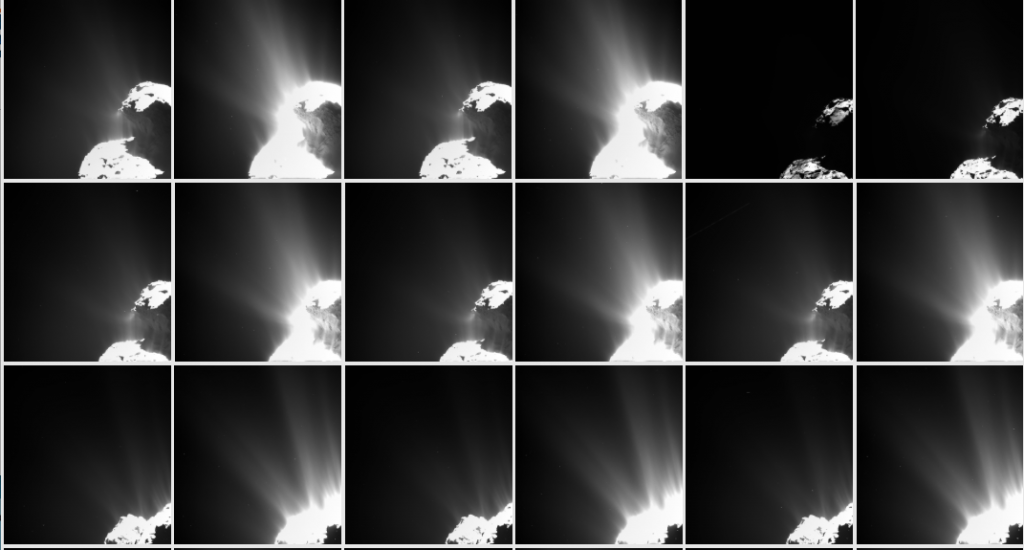Remember the stunning image Rosetta snapped of its own shadow last year? This was just one of twelve images taken by the OSIRIS narrow-angle camera during the 6 km flyby of Comet 67P/Churyumov-Gerasimenko on 14 February 2015 that captured the shadow, and which have today been released into the Archive Image Browser and the Planetary Science Archive.

Animation showing Rosetta’s shadow move across the surface of Comet 67P/Churyumov-Gerasimenko during the 14 February 2015 flyby. The sequence lasts from 12:38 to 12:41 UT. The full resolution images can be downloaded from the Archive. Credits: ESA/Rosetta/MPS for OSIRIS Team MPS/UPD/LAM/IAA/SSO/INTA/UPM/DASP/IDA
This latest OSIRIS data release comprises 1357 narrow-angle camera images and 2162 wide-angle camera images from the period 20 December 2014 – 10 March 2015. During this time Rosetta was initially in ~28 km orbits around the comet. In early February the spacecraft moved out to 142 km before swooping past the comet at 6 km on 14 February and away again (this video visualizes Rosetta’s trajectory at that time).
The 14 February flyby was not only special because it was the closest Rosetta had ever been to the surface of the comet at that time but it also passed through a unique observational geometry: for a short time the Sun, spacecraft, and comet were exactly aligned. In this geometry, surface structures cast almost no shadows, and therefore the reflection properties of the surface material can be determined. As a side effect, Rosetta’s shadow could also be seen, cast on the surface of the comet as a fuzzy rectangular-shaped dark spot surrounded by a bright halo-like region. The shadow is fuzzy and somewhat larger than Rosetta itself, measuring approximately 20 x 50 metres. (For more information about this effect see last year’s blog post “Comet flyby: OSIRIS catches glimpse of Rosetta’s shadow“).

Example of images from the OSIRIS wide-angle camera albums in the latest data release. Credits: ESA/Rosetta/MPS for OSIRIS Team MPS/UPD/LAM/IAA/SSO/INTA/UPM/DASP/IDA
The data release also contains many other beauty shots of the comet from both near and far, with the wide-angle camera shots in particular capturing the comet’s ever-increasing activity at that time.
Also today, 540 new NAVCAM images were added to the Archive Image Browser. The latest batch cover the period 4-31 May 2016 and as such include images from the close flyby that took Rosetta to within 5 km of the surface.
For more recent OSIRIS images, see the OSIRIS image of the day archive.










Discussion: 18 comments
Hi Emily
I was going to ask you when the embargo on the Valentine’s Day photo was being lifted because I did a gif showing a nice match of two sections of crust perimeter, 700 metres apart, either side of the smooth terrain. I won’t say it stretched, or slid, or flew…but it is unequivocally a match and requires an explanation that’s consistent with current theories thus far put forward by OSIRIS for the morphology of 67P.
https://scute1133site.wordpress.com/photos-for-off-site-comments/
Please scroll to ‘comment 4’ which is at the bottom with two gifs and 6 photos, all derived from that famous 6km altitude panorama of Imhotep.
A tracking shot of the fly-by
https://bit.ly/29918z7
… the distance reported is the spacecraft / center of the comet.
Every day more convinced that Coraline is a ‘core of a core’, or just a ‘chip of the block’, as the parishioners have said here.
https://blogs.esa.int/rosetta/files/2016/06/CometactivityWAC.png
Aparent balancing rock at pixel 427,582 of
https://imagearchives.esac.esa.int/picture.php?/63617/category/260
ROS_CAM1_20160507T095100
https://imagearchives.esac.esa.int/picture.php?/63614/category/260
Even if material fragile, low gravity and progressive sinter should allow for some ‘impossibly ethereal’ sublimation framings. As slightly suggested by some arrival shots… Future weeks will tell if those were just mirages.
Aparent sound wave drawings around pixel 284,476 of
https://imagearchives.esac.esa.int/picture.php?/63625/category/260
ROS_CAM1_20160507T194421
Could We think of the neck -gravitationally and dust transport wise- as the deepest of the basins?
There is a global ‘hydrology’ of ultra-cold gases, after dusk phenomena, gently washing electrostatic|’percolating’ levitated|just-deposited micro-dust..
Thanks a lot to OSIRIS Team about the new Public Release, including the shadow fly-by 😀
So [if ultra-cold gas ‘hydrology’], It does rain under our astronaut boots, at 67P.
[All my comments are pure wandering and wondering].
Not water rain [but maybe including a little brine likes].
About brine likes, arguments about dominance of capillarity just saying that ammonia is not a small presence at 67P.. For others substances highly capillary, well, we could have BIG, dirty drops.. Nothing of this apply to primary material.
This model also makes the global ‘cascades’ in between lobes also feasible. Not ‘sandy’ as formerly suspected. But ‘smoggy’. Maybe even ‘dusty’ at perihelion dusks.
This cryo-rock is so beautiful that deserves a name on its own:
Pixel 569,260 of:
ROS_CAM1_20160515T144939
https://imagearchives.esac.esa.int/picture.php?/63784/category/260
Going to tag it “The Puff Pastry”.
Clues of surroundings suggest being part of the lattice containing it.
Have started the review of these Libraries and can’t stop saying ESA and every Soul involved Thanks from heart, about the privilege. 67P is indeed, an alien little World.
Now about perception [mine]: On seeing a 2D map with both eyes, tend to see features as a planar. On using a single eye, forces mind to make 3D interpretation. Usually one being better than the other, but should give sight a rest.
Not ‘ruble’ in the random sense, but in the ‘Lego’s.
…’pasta’ fields.
No ‘glaciers’. Just a dusty, interminable glacée|un-glacée over that ‘puff pastry’.